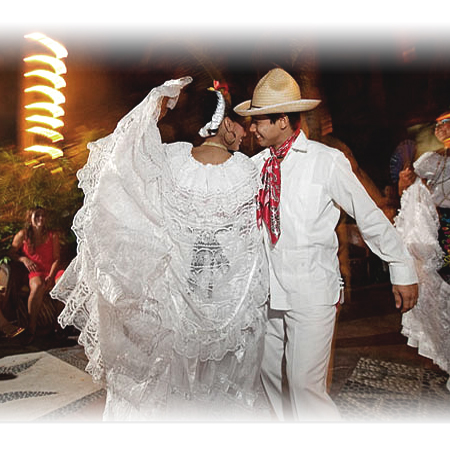Culture Club: Mexico-Mexican Wedding Traditions

Weddings are a big deal in all cultures. Every culture recognizes the importance of two people coming together and pledging to love each other in good times and bad, in sickness and health, to death parts them. The only constant in global cultures is that weddings involve the two people getting married. Beyond that, there are countless cultural differences, rituals, and traditions that together weave a richly embellished wedding story. In a new series, called Culture Club, we’ll look at other cultures around the world and dive into some of their wedding traditions and rituals. Our inaugural installment features a culture that is close to home for many Americans: Mexico.
First and foremost, the religious wedding ceremony is of the utmost importance to most Mexican couples. As most couples in Mexico are Catholic, many of the wedding traditions we’ll discuss today are based in that religious identity. One of the first things that struck me about Mexican weddings is that despite the majority of the population strongly identifying as Catholics, the Mexican government does not recognize the religious ceremony as an official legal ceremony. As a result, most Mexican couples get married by a justice of the peace. A judge makes a little speech about marriage, performs the legal wedding, and then the bride and groom, along with four witnesses, sign the marriage license. At that point, the couple is married, as far as the government is concerned. But most Mexicans place a greater level of significance on the religious ceremony. The religious and legal ceremonies usually take place on the same day, with the legal one performed first.
Another facet of Mexican weddings which may be unfamiliar to many Americans (including me) is the question of cost and payment responsibility. Mexican couples have madrinas and padrinos, who are sponsors of the couple. In addition to providing counsel, advice, and support, these “godparents” often also assist with the wedding financially. Often, these people are parents, grandparents, or aunts and uncles.
The financial burden of a wedding also has some differences based on geography. Couples in larger urban areas are often more progressive, with the younger generations having been influenced strongly by American wedding and marriage customs. In larger areas, the majority of the financial support comes from the bride’s family. However, in more rural areas (where the guests of the wedding comprise a disproportionately large share of the inhabitants), it is not uncommon for extended family and friends to help with the planning, preparation, and financial support for the food, music, venue, etc.
The wedding attire has become increasingly more Americanized, with the bride wearing a large white dress and the groom donning a tuxedo. However, traditionally, the groom wears linen pants and a “wedding shirt,” which is a four-pocketed shirt with two rows of small pleats, usually made of linen also. In a more traditional setting, the bride’s dress will be sewn by her family members at the expense of her future husband’s family. The style and embellishments on the dress vary with the region and wealth of the family. There are so many variations that can be seen in the bride’s attire that they’re just too numerous to mention here. I encourage you to do some research though. You’ll find clothing that will take your breath away. Depending on the dress code requirements at the church she’s getting married in, the bride may also have to wear a dress that covers her shoulders or wear a bolero (or other small) jacket. In addition to, or instead of, a long American veil, many Mexican brides opt for a mantilla. A mantilla is a veil, usually made of lace or silk, that covers the bride’s shoulders. In weddings, white is the most often-worn color. The mantilla is held up by a tall comb called a pieneta. The mantilla originated in Spain and although it fell out of everyday wear favor by the early 1900s, it is still worn for weddings and high holy days in the Catholic church.
The last facet of Mexican wedding traditions I’d like to open your eyes to today is that of the arras. The arras is a collection of 13 golden coins given to the bride by the groom. They symbolize Jesus Christ and his 12 apostles. The coins further symbolize the groom’s commitment to supporting his wife. In accepting the coins, the bride is acknowledging her trust and faithfulness in her husband. The coins are kept in an ornate box and become a family heirloom.
It is fascinating to learn about different cultures, especially in light of a cultural experience that most people can identify with, like weddings. I hope this has widened your horizons a little bit and has given you one more thing to admire about other cultures.
Until next time,
Rebecca
Share This Page:












